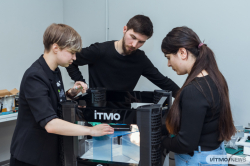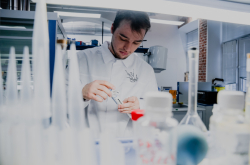How much money do the government and business spend on science?
In 2015, Russia invested 914,7 billion rub in R&D at the accession rate of 0.2% a year. This makes Russia 9th in the world according to the statistics. Yet, 914,7 billion equals to only 1.13% percent to GDP, which places Russia 34thamong other countries, where the Republic of Korea (4.29%), Israel (4.11%), Japan (3.59%), Finland (3.17%) and Sweden (3.16%) make up the top-five.
What does it mean? Is the expenditure on science in Russia small or large in comparison with other countries?
According to Konstantin Fursov, head of the Institute for Statistical Studies and Economics of Knowledge of the Higher School of Economics, in the form of absolute value, Russia spends a lot on science. Yet, if we look at this money as a share of the country’s GDP, the situation becomes different: it turns out that in comparison with Great Britain, for instance, Russia spends much fewer.
Mr. Fursov also adds that apart from scope of financing, one has to reckon with sources. In almost all states, apart from those with centralized governments, businesses invest in research. This shows to which extent is science integrated into civic economy. Russian science is financed mostly by the government.

Konstantin Fursov
In 1995, the Russian Government sponsored 67% of all research projects, in 2014 — 60%. The share of investments by entrepreneurs remained roughly the same — about 27%. From 2000 to 2015, the share of investments by the business sector decreased from 32.9 to 26.5%. 64% of research establishments are governmental, 21% are private.
What kinds of research are prevalent?
These days, the greatest expenses go to research in the field of transport and space systems (219.2 billion rubles.) It is more than one third (34.9%) of Russia’s total expenditure on science. In comparison, 13.7% are spent on "Nuclear power industry, energy efficiency and preservation," 11.9% on "Information and telecommunication systems," and only 4.1% for "Nanosystem Industry," which is a very popular field all over the world these days.
Russia is still "a country of engineers." In 2005, the amount of researchers dealing with STEM fields was 250,000 peopleand., in 2014, it was only about 20,000 people less. At the same time, the number of scientists conducting research in humanities grew by 30−40%. However, the total amount of them is only 13,000 people. There are 16,000 people dealing with medical science and 90,000 working in natural sciences.
As for the number of publications in scientific magazines, it proves the numbers given above — 56% of papers are related to natural and exact sciences, about 30% are related to engineering subjects, and 7,7% - to medical ones.

What is behind the publication activity of Russian researchers?
In 2000−2014, the journals indexed in Web of Science included 144,270 articles written by Russians. Australian and Switzerland researchers, for instance, published twice as little. However, the number of citations of their articles was several times higher. Chinese researches published six times as much as Russians, but each their article was cited only 1,5 times much as Russian ones. The journals indexed in Scopus have similar results.
What is more important for evaluating the scientific possibilities of a country, the number of publications or the number of links to an article?
"The number of citations is more important. However, it is necessary to take into account not only the citations per paper, but also the citation rate of all articles presented by a country (otherwise a small country can suddenly be seen as leader.) Citation doesn’t have to be the only criterion. The fact that citation rate prevails over other indicators is already a matter of deep concern among the scientific community. In addition, more and more scientists cite each other using the "logrolling" principle," says Igor Popov, head of ITMO’s Department of Advanced Mathematics and editor of the"Nanosystems: Physics, Chemistry, Mathematics".
The expert named the reasons for Russia’s lag in citation rate. The first one is the scientific stagnation that started at the beginning of 1900-ss and continued for over 15 years. Despite the fact that now Russia faces a kind of science renaissance, it is impossible to create a perfect system in such a short period of time. The second reason is that citation rate is based on WoS and Scopus indexes only — both include few Russian journals. American scientists cite Americans only, Europeans cite their colleagues form America and Europe, ignoring Asians and Russians. "This makes us vulnerable," explains Mr. Igor Popov.

Furthermore, top Russian journals have double versions, translated into English, that are included in databases. Russian and English versions of one journal are considered separate scientific publications — it means that if one cites the original article in Russian and not the English translation, it is not taken into account.
Igor Popov also mentions one other reason. Traditionally, Russia has well-versed mathematicians and programmers. However, articles written in these two fields have less links (which makes their citation rates low). On the contrary, articles on medicine and biology, unfortunately Russians are far from being leaders in them, always have lots of links.
Andrey Loktev, consultant for information solutions at the Russian branch of Elsevier Science and Technology (S&T), thinks that apart from citation rate itself, one has to take into account when the measurements were done, to what field the work is related, what kinds of papers are compared, and so forth. It would be better to cover both quantitative evaluation and expert analyses.
According to the report, there is also a positive trend in publication activity. For a long period of time, the number of Russian articles in Web of Science has been decreasing — in 2013, it reached the minimum, 2.08%. However, the situation changed in subsequent years. In 2014−2015, it grew up to 2.31%. However, the average annual accession rate is still the same as 15 years ago — 2.3%, which is quite low in comparison with the overall numbers for the world (5.6%.) The statistics for Scopus look similar.
Who Russian scientists are?
The number of employees of state, private and university-based research centers (not only researchers, but all staff members) is increasing gradually. In 2008, there were 33,000 employees, in 2014 — 44,000. The number of researchers younger than 29 is also growing — starting from 2008, it has increased by 3%. There are more scientists under 39, as well — their number has increased by 7%. However, the average age of scientists in Russia has grown from 45 to 47.
"The average age of scientists is growing because the influx of new researchers is slower than the process of natural aging. Furthermore, young people are mobile in terms of places of living. They choose a profession later than their predecessors and change their fields of activity frequently," says Olga Kononova, head of Department of Human Resources Management and Fundraising.

There are historical reasons for these statistics, as well. 24−29 year old men and women were born in the period of the demographic crisis of 1988−1993. Those who were born in 1978 and later studied in high school when the Soviet Union was dissolved. Then in 1998, they face the market crash which made professional self-identification a lot more difficult.
What do Russians invent?
According to the Higher School of Economic’s report, inventive activity is measured by the number of patents. In 2000−2015, Russian and international inventors submitted 45,500 applications to the National Patent Board of Russia, which is 1,6 times higher than in the previous period (28,700 vs 45,500). This growth was caused by increased activity of foreign inventors. For the last 15 years, the number of such applications has tripled. In 2015, it reached 16, 000. This means that entrepreneurs from overseas are very interested in the Russian intellectual property market. As for the number of applications from Russians, during the last 15 years it has increased by 25%. Most patents in Russia are in tech innovations, transport, chemistry and metallurgy.




